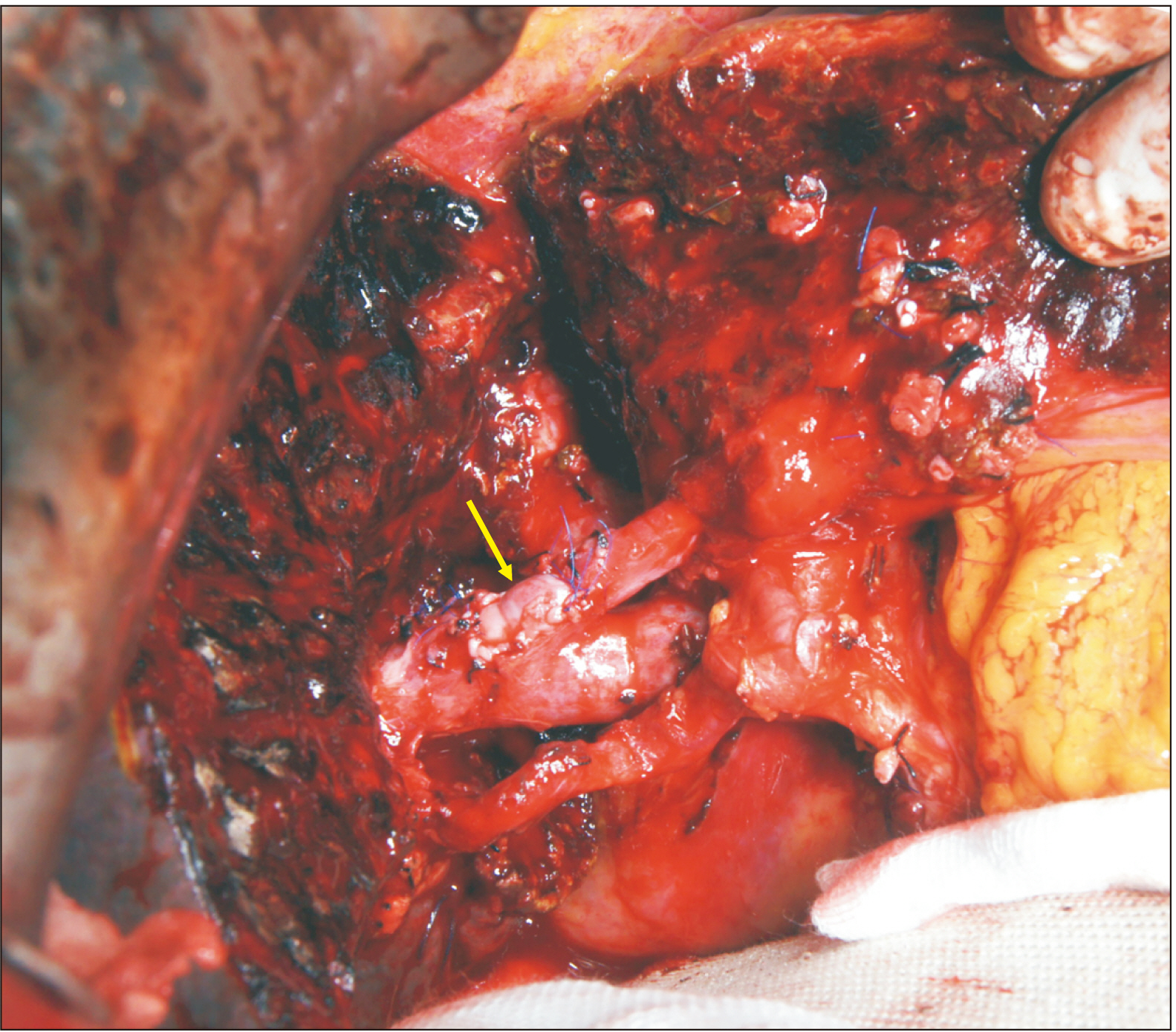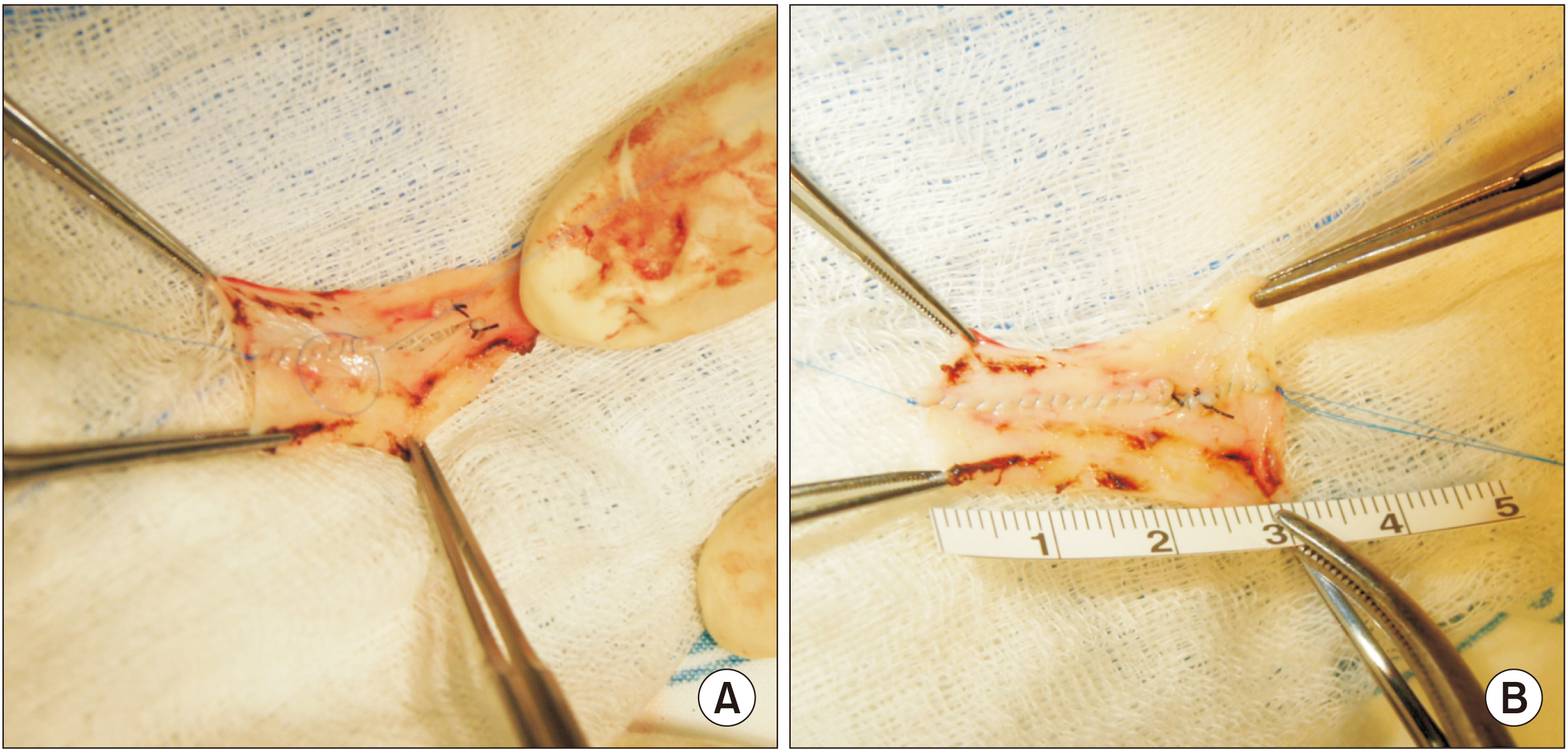Ann Hepatobiliary Pancreat Surg.
2021 Nov;25(4):509-516. 10.14701/ahbps.2021.25.4.509.
Portal vein wedge resection and patch venoplasty using autologous and homologous vein grafts during surgery for hepatobiliary malignancies
- Affiliations
-
- 1Department of Surgery, Asan Medical Center, University of Ulsan College of Medicine, Seoul, Korea
- KMID: 2523055
- DOI: http://doi.org/10.14701/ahbps.2021.25.4.509
Abstract
- Obtaining tumor-free resection margins is one of the most important factors for achieving favorable prognosis of patients undergoing resection for hepatobiliary malignancies. In this study, we present our experience of portal vein (PV) wedge resection and patch venoplasty using autologous or homologous vessel grafts for resecting perihilar cholangiocarcinoma, hepatocellular carcinoma, and distal bile duct cancer. Case 1 was 68-year-old male patient with type IV perihilar cholangiocarcinoma who underwent central bisectionectomy with caudate lobectomy and bile duct resection, and PV wedge resection and patch venoplasty with a cryopreserved iliac vein allograft patch. This patient survived 14 months after surgery. Case 2 was 77-year-old male patient with type IIIA perihilar cholangiocarcinoma who underwent left medial sectionectomy with caudate lobectomy, bile duct resection, and PV wedge resection and patch venoplasty with a cryopreserved iliac vein allograft patch. This patient survived 17 months after surgery. Case 3 was 54-year-old male patient with hepatitis B virus-associated liver cirrhosis and hepatocellular carcinoma with PV tumor thrombus who underwent left hepatectomy. The PV wall defect was repaired with an autologous greater saphenous vein patch. This patient survived 11 months after surgery. Case 4 was 65-year-old female patient with distal bile duct cancer who underwent pylorus-preserving pancreaticoduodenectomy, and main PV wedge resection and patch venoplasty with a cryopreserved iliac artery allograft patch. This patient survived 21 months after surgery. In conclusion, PV wedge resection and patch venoplasty can be used to facilitate complete tumor resection in patients undergoing various extents of surgical resection for hepatobiliary malignancies.
Figure
Reference
-
1. Chen W, Ke K, Chen YL. 2014; Combined portal vein resection in the treatment of hilar cholangiocarcinoma: a systematic review and meta-analysis. Eur J Surg Oncol. 40:489–495. DOI: 10.1016/j.ejso.2014.02.231. PMID: 24685155.
Article2. Wu XS, Dong P, Gu J, Li ML, Wu WG, Lu JH, et al. 2013; Combined portal vein resection for hilar cholangiocarcinoma: a meta-analysis of comparative studies. J Gastrointest Surg. 17:1107–1115. DOI: 10.1007/s11605-013-2202-9. PMID: 23592188.
Article3. Ebata T, Nagino M, Kamiya J, Uesaka K, Nagasaka T, Nimura Y. 2003; Hepatectomy with portal vein resection for hilar cholangiocarcinoma: audit of 52 consecutive cases. Ann Surg. 238:720–727. DOI: 10.1097/01.sla.0000094437.68038.a3. PMID: 14578735. PMCID: PMC1356151.4. Hwang S, Ha TY, Jung DH, Park JI, Lee SG. 2007; Portal vein interposition using homologous iliac vein graft during extensive resection for hilar bile duct cancer. J Gastrointest Surg. 11:888–892. DOI: 10.1007/s11605-007-0146-7. PMID: 17440791.
Article5. Kim SM, Hwang S. 2021; Hilar portal vein wedge resection and patch venoplasty in patients undergoing bile duct resection for hepatobiliary malignancy: a report of two cases. Ann Hepatobiliary Pancreat Surg. 25:132–138. DOI: 10.14701/ahbps.2021.25.1.132. PMID: 33649266. PMCID: PMC7952668.
Article6. Amin MB, Edge S, Greene F, Byrd DR, Brookland RK, Washington MK, et al. 2017. AJCC cancer staging manual. 8th ed. Springer;New York: DOI: 10.1007/978-3-319-40618-3.7. Hwang S, Ha TY, Ko GY, Kwon DI, Song GW, Jung DH, et al. 2015; Preoperative sequential portal and hepatic vein embolization in patients with hepatobiliary malignancy. World J Surg. 39:2990–2998. DOI: 10.1007/s00268-015-3194-2. PMID: 26304608.
Article8. Sakamoto Y, Yamamoto J, Saiura A, Koga R, Kokudo N, Kosuge T, et al. 2004; Reconstruction of hepatic or portal veins by use of newly customized great saphenous vein grafts. Langenbecks Arch Surg. 389:110–113. DOI: 10.1007/s00423-003-0452-9. PMID: 15004752.
Article9. Lin CC, Hsieh CE, Chen YL. 2013; Great saphenous vein harvesting for venous outflow reconstruction in living donor liver transplantation - a minimally invasive refinement of the conventional procedure. Int J Surg. 11:249–252. DOI: 10.1016/j.ijsu.2013.01.004. PMID: 23352846.
Article10. Hwang S, Ko GY. 2020; Right trisectionectomy with en bloc portal vein resection for cholangiocarcinoma after preoperative stenting for main portal vein occlusion. Ann Hepatobiliary Pancreat Surg. 24:174–181. DOI: 10.14701/ahbps.2020.24.2.174. PMID: 32457263. PMCID: PMC7271116.
Article11. Namgoong JM, Hwang S, Oh SH, Kim KM, Park GC, Ahn CS, et al. 2020; Living-donor liver transplantation with inferior vena cava replacement in an infant recipient with advanced hepatoblastoma. Ann Hepatobiliary Pancreat Surg. 24:72–77. DOI: 10.14701/ahbps.2020.24.1.72. PMID: 32181433. PMCID: PMC7061035.
Article12. Kwon H, Kwon H, Hong JP, Han Y, Park H, Song GW, et al. 2015; Use of cryopreserved cadaveric arterial allograft as a vascular conduit for peripheral arterial graft infection. Ann Surg Treat Res. 89:51–54. DOI: 10.4174/astr.2015.89.1.51. PMID: 26131446. PMCID: PMC4481033.
Article13. Hwang S, Moon DB, Kim KH, Ahn CS, Song GW, Jung DH, et al. Prognostic accuracy of the ADV score following resection of hepatocellular carcinoma with portal vein tumor thrombosis. J Gastrointest Surg. 2020; https://doi.org/10.1007/s11605-020-04800-6 [in press]. DOI: 10.1007/s11605-020-04800-6. PMID: 32948961.
Article14. Edge SB, Byrd DR, Compton CC, Fritz AG, Greene FL, Trotti A III. 2010. AJCC cancer staging manual. 7th ed. Springer;New York:15. Maeta T, Ebata T, Hayashi E, Kawahara T, Mizuno S, Matsumoto N, et al. 2017; Pancreatoduodenectomy with portal vein resection for distal cholangiocarcinoma. Br J Surg. 104:1549–1557. DOI: 10.1002/bjs.10596. PMID: 28782798.
Article
- Full Text Links
- Actions
-
Cited
- CITED
-
- Close
- Share
- Similar articles
-
- Hilar portal vein wedge resection and patch venoplasty in patients undergoing bile duct resection for hepatobiliary malignancy: A report of two cases
- Usability of cryopreserved homologous great saphenous vein for hepatobiliarypancreatic surgery and living donor liver transplantation
- Clinical applicability of autologous great saphenous vein for living donor liver transplantation
- Reconstruction of portal vein and superior mesenteric vein after extensive resection for pancreatic cancer
- Techniques of Oncovascular Reconstruction of Portal and Mesenteric Veins during Pancreatic and Hepatobiliary Surgery










